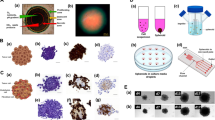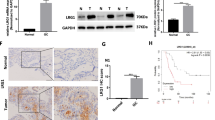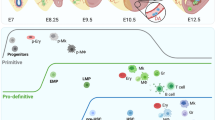Abstract
Previous studies have shown that endothelial colony forming cells (ECFCs) play an important role in the neovascularization of tumors. Hypoxia is emphasized as an important promoter of angiogenesis. However, little is known about genome-wide transcriptional regulation of ECFCs under hypoxic conditions. In this study, gene expression profiles in ECFCs were evaluated under hypoxic conditions for 3, 6, 12, 24, and 48 h, using Affymetrix U133 plus 2.0 chip microarray. 1,103 hypoxia-regulated genes were filtered, with 379 (0.693 %) genes up-regulated and 724 (1.32 %) genes down-regulated. Most of the up-regulated genes were involved in apoptosis, cell proliferation, or metabolic processes, while most of the down-regulated genes were involved in cell adherence, cell cycle, DNA and mRNA metabolic processes, multi-cellular organism development, protein metabolic processes, response to stress, signal transduction, or transport. This expression profile is ECFC-specific, because it is significantly different from those of endothelial cells and smooth muscle cells under hypoxic conditions. Moreover, hypoxia-regulated apoptosis in ECFCs is mainly related with the mitochondrial pathway (p53-BAX-Caspase-9) and the death receptor pathway (FAS-Caspase-8-Caspase-3). MAPK pathway is activated in ECFCs under hypoxic conditions. The differentially expressed genes of ECFCs were identified under hypoxic conditions, and related with cell apoptosis, cell cycle and MAPK pathways, shedding light on the mechanism of angiogenesis.








Similar content being viewed by others
References
Alavi A, Hood JD, Frausto R, Stupack DG, Cheresh DA (2003) Role of Raf in vascular protection from distinct apoptotic stimuli. Science 301:94–96
Berra E, Milanini J, Richard DE, Le Gall M, Vinals F, Gothie E, Roux D, Pages G, Pouyssegur J (2000) Signaling angiogenesis via p42/p44 MAP kinase and hypoxia. Biochem Pharmacol 60:1171–1178
Diez H, Fischer A, Winkler A, Hu CJ, Hatzopoulos AK, Breier G, Gessler M (2007) Hypoxia-mediated activation of Dll4-Notch-Hey2 signaling in endothelial progenitor cells and adoption of arterial cell fate. Exp Cell Res 313:1–9
Ding YT, Kumar S, Yu DC (2008) The role of endothelial progenitor cells in tumour vasculogenesis. Pathobiology 75:265–273
Eichler W, Yafai Y, Wiedemann P, Reichenbach A (2004) Angiogenesis-related factors derived from retinal glial (Muller) cells in hypoxia. NeuroReport 15:1633–1637
Eliceiri BP, Paul R, Schwartzberg PL, Hood JD, Leng J, Cheresh DA (1999) Selective requirement for Src kinases during VEGF-induced angiogenesis and vascular permeability. Mol Cell 4:915–924
Gao D, Nolan DJ, Mellick AS, Bambino K, McDonnell K, Mittal V (2008) Endothelial progenitor cells control the angiogenic switch in mouse lung metastasis. Science 319:195–198
Gold’berg ED, Dygai AM, Zyuz’kov GN, Gur’yantseva LA, Suslov NI (2002) Mechanisms of changes in the erythroid hemopoietic stem during hypoxias of different severity. Bull Exp Biol Med 134:122–125
Gupta K, Kshirsagar S, Li W, Gui L, Ramakrishnan S, Gupta P, Law PY, Hebbel RP (1998) VEGF prevents apoptosis of human microvascular endothelial cells via opposing effects on MAPK/ERK and SAPK/JNK signaling. Mol Biol Cell 9:622
Hayashi M, Sakata M, Takeda T, Tahara M, Yamamoto T, Okamoto Y, Minekawa R, Isobe A, Ohmichi M, Tasaka K et al (2005) Up-regulation of c-met protooncogene product expression through hypoxia-inducible factor-1 alpha is involved in trophoblast invasion under low-oxygen tension. Endocrinology 146:4682–4689
Ivanovic Z, Hermitte F, De La Grange PB, Dazey B, Belloc F, Lacombe F, Vezon G, Praloran V (2004) Simultaneous maintenance of human cord blood SCID-repopulating cells and expansion of committed progenitors at low O-2 concentration (3%). Stem Cells 22:716–724
Jiang M, Wang B, Wang C, He B, Fan H, Guo TB, Shao Q, Gao L, Liu Y (2006) Inhibition of hypoxia-inducible factor-1alpha and endothelial progenitor cell differentiation by adenoviral transfer of small interfering RNA in vitro. J Vasc Res 43:511–521
Liu T, Laurell C, Selivanova G, Lundeberg J, Nilsson P, Wiman KG (2007) Hypoxia induces p53-dependent transactivation and Fas/CD95-dependent apoptosis. Cell Death Differ 14:411–421
Lyden D, Hattori K, Dias S, Costa C, Blaikie P, Butros L, Chadburn A, Heissig B, Marks W, Witte L et al (2001) Impaired recruitment of bone-marrow-derived endothelial and hematopoietic precursor cells blocks tumor angiogenesis and growth. Nat Med 7:1194–1201
Manalo DJ, Rowan A, Lavoie T, Natarajan L, Kelly BD, Ye SQ, Garcia JGN, Semenza GL (2005) Transcriptional regulation of vascular endothelial cell responses to hypoxia by HIF-1. Blood 105:659–669
Meadows KN, Bryant P, Pumiglia K (2001) Vascular endothelial growth factor induction of the angiogenic phenotype requires Ras activation. J Biol Chem 276:49289–49298
Mellick AS, Plummer PN, Nolan DJ, Gao D, Bambino K, Hahn M, Catena R, Turner V, McDonnell K, Benezra R et al (2010) Using the transcription factor inhibitor of DNA binding 1 to selectively target endothelial progenitor cells offers novel strategies to inhibit tumor angiogenesis and growth. Cancer Res 70:7273–7282
Nolan DJ, Ciarrocchi A, Mellick AS, Jaggi JS, Bambino K, Gupta S, Heikamp E, McDevitt MR, Scheinberg DA, Benezra R et al (2007) Bone marrow-derived endothelial progenitor cells are a major determinant of nascent tumor neovascularization. Genes Dev 21:1546–1558
Piret JP, Minet E, Cosse JP, Ninane N, Debacq C, Raes M, Michiels C (2005) Hypoxia-inducible factor-1-dependent overexpression of myeloid cell factor-1 protects hypoxic cells against tert-butyl hydroperoxide-induced apoptosis. J Biol Chem 280:9336–9344
Strauer BE, Brehm M, Zeus T, Kostering M, Hernandez A, Sorg RV, Kogler G, Wernet P (2002) Repair of infarcted myocardium by autologous intracoronary mononuclear bone marrow cell transplantation in humans. Circulation 106:1913–1918
Yamasaki M, Nomura T, Sato F, Mimata H (2007) Metallothionein is up-regulated under hypoxia and promotes the survival of human prostate cancer cells. Oncol Rep 18:1145–1153
Yu DC, Sun XT, Qiu YD, Zhou JX, Wu YF, Zhuang LY, Chen J, Ding YT (2007) Identification and clinical significance of mobilized endothelial progenitor cells in tumor vasculogenesis of hepatocellular carcinoma. Clin Cancer Res 13:3814–3824
Yu DC, Chen J, Ding YT (2010a) Hypoxic and highly angiogenic non-tumor tissues surrounding hepatocellular carcinoma: the ‘niche’ of endothelial progenitor cells. Int J Mol Sci 11:2901–2909
Yu DC, Chen J, Sun XT, Zhuang LY, Jiang CP, Ding YT (2010b) Mechanism of endothelial progenitor cell recruitment into neo-vessels in adjacent non-tumor tissues in hepatocellular carcinoma. BMC Cancer 10:435
Acknowledgments
This study was supported by the Grants for Natural Science grants in Jiangsu Province (BK200862), Outstanding Physicians in Jiangsu Province, National Natural Science Foundation of China (General Program; 30972904, 81201621). And thank GENG Tuo-yu in Medical University of South Carolina (MUSC) for the discussion about this study, and Thomas G. Smith of the MUSC Writing Centers for editing the manuscript.
Author information
Authors and Affiliations
Corresponding author
Additional information
De-Cai Yu and Wen-Du Feng contributed equally to this study.
Electronic supplementary material
Below is the link to the electronic supplementary material.
13258_2012_55_MOESM2_ESM.xls
Supplementary material Supplementary Table 1. The information of 1,103 hypoxia-inducible differentially expressed genes (XLS 472 kb)
Rights and permissions
About this article
Cite this article
Yu, DC., Feng, WD., Shi, XB. et al. Dynamic analysis for gene expression profiles of endothelial colony forming cells under hypoxia. Genes Genom 35, 451–462 (2013). https://doi.org/10.1007/s13258-012-0055-3
Received:
Accepted:
Published:
Issue Date:
DOI: https://doi.org/10.1007/s13258-012-0055-3




